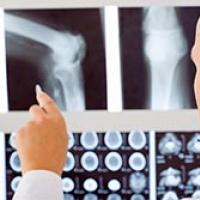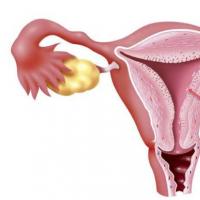Diffuse changes in the pancreas what to do. Treatment of diffuse changes in the pancreas. Diagnosis of such changes includes
Most patients, having read in the conclusion of the ultrasound that they have diffuse changes in the pancreas, begin to come up with non-existent diagnoses. This wording does not always mean the presence of a disease. She informs the doctor that there are deviations from the norm, which should be paid attention to if there are other complaints and symptoms in the patient. Let's see why these changes occur.
Where and how can you see it
Any organ, including the pancreas, reflects ultrasonic waves during ultrasound examination. The key signs of diffuse changes in an organ are a decrease or increase in its ability to absorb an ultrasonic wave compared to normal parameters. This is due to the fact that the number of functioning cells of the pancreas decreases, and they begin to be replaced by adipose or connective tissue.
Echo-signs of changes may concern the entire organ or its separate area (local focus). Such ultrasound signs may indicate a past or acute inflammatory process or signal a violation of the blood supply to the pancreas. Certain changes in the pancreas occur with age, so this factor has to be taken into account.
Causes of this problem
There are more than a dozen different reasons that contribute to a change in the structure of the pancreas. Most often, such changes indicate a violation of metabolic and hormonal processes in the body. They can be observed in patients with chronic and acute pancreatitis, tumors, cysts and other diseases of this organ. In addition, the causes of diffuse changes can be: 
- diseases of the digestive tract;
- hereditary factor;
- alcohol abuse;
- beriberi and nutritional errors, an abundance of fatty and fried foods;
- transferred surgical interventions on the pancreas;
- the effect of certain drugs.
This condition is rare in children. It may be associated with a burdened heredity in a child, as well as with a congenital stricture of the pancreatic duct. In the elderly, mild and moderate diffuse changes in the absence of other symptoms are considered a variant of the norm, since with age, degenerative-dystrophic processes are observed in all tissues and organs.
What does the detection of such a rearrangement of the gland mean?
The appearance of such signs on ultrasound is not a diagnosis, but only indicates that a change in structure is observed in the tissue of the organ, and it is necessary to find out what caused this. Changes can only affect the parenchyma of the gland. This suggests that there are no neoplasms, stones and other local foci in the organ, but the parenchyma of the entire gland has undergone restructuring. Changes in the pancreatic parenchyma may be a sign of the following diseases:
- acute and chronic forms of pancreatitis;
- diabetes;
- diffuse lipomatosis.
In these cases, in addition to the appearance of diffuse changes, there is an increase or decrease in the density (echogenicity) of the pancreas. In cases where these signs are determined by ultrasound, the patient is referred for additional examinations to verify the diagnosis. Changes can also affect the structure of the body. It reveals individual foci of increased or decreased echogenicity, which may indicate a cyst, tumor, or local lipomatosis.
With changes in the pancreas by the type of lipomatosis, ultrasound reveals diffuse or local foci of adipose tissue, which are characterized by increased echogenicity. With focal lipomatosis in the pancreas, a diffusely heterogeneous structure is determined, and with diffuse lipomatosis, the echogenicity of the entire gland changes evenly. 
What are the symptoms of this condition?
The clinical picture and symptoms depend on the underlying pathology that caused the restructuring of the organ. The patient may feel heaviness in the stomach, pain in the epigastric region on the left, belching, heartburn and problems with stool. Diseases and their symptoms that may be accompanied by this ultrasound sign:
- Acute pancreatitis. The patient complains of severe pain in the left hypochondrium. Repeated vomiting does not alleviate the patient's condition. The temperature rises and the pressure readings change. There is bloating and diarrhea with a fetid odor.
- Chronic pancreatitis. Outside of an exacerbation, the patient may be disturbed by heaviness in the abdomen after eating and occasional discomfort in the left hypochondrium. During the period of exacerbation, the attack resembles an acute form.
- Lipomatosis is a systemic pathology in which gland tissues are replaced by fat cells. Symptoms appear in the last stages. Ultrasound allows you to identify changes in the initial stages and take the necessary measures to treat and stop the progression of the process.
- Fibrosis (sclerosis) is a condition in which gland cells are replaced by connective tissue. Initially, the patient is concerned about general symptoms: nausea, heaviness in the abdomen, discomfort in the region of the gland. Then signs of endocrine insufficiency join, and diabetes mellitus develops.
Principles of therapy
Treatment of such changes is carried out only in the case when the patient is concerned about some symptoms or the process is pathological.
- In acute pancreatitis, the patient is recommended cold, hunger and rest. In parallel, painkillers, antispasmodics and enzyme preparations are prescribed. Then they put him on a special diet and continue drug therapy.
- Chronic pancreatitis without exacerbation forces the patient to constantly follow a certain diet and take enzyme preparations if necessary.
- With diabetes, the patient rebuilds his diet and controls the level of glucose in the blood. With decompensation of pancreatic function, insulin preparations are prescribed.
- With lipomatosis, diet and lifestyle control are of primary importance.
- For neoplasms, cysts, or blockage of the duct, surgical treatment may be necessary.
- Age-related diffuse changes are not treated, the patient is advised to adhere to a healthy diet and proper lifestyle.
It is impossible to cure changes that have occurred in the pancreas. Treatment is aimed at maintaining the function of the organ and eliminating unpleasant symptoms.
What you need to know about nutrition
The choice of diet for problems with the pancreas depends on the diagnosis. General principles of nutrition in pathological processes in this organ:
- giving up alcohol and smoking;
- restriction or complete exclusion of fried, spicy and salty foods;
- fractional meals in small portions;
- restriction or exclusion of sweets, pastries and confectionery;
- drinking the optimal amount of water.
The diet is selected depending on the severity of the pathological process and the individual characteristics of the patient. Diffuse changes in the pancreas are not a sentence, but a reason to pay attention to your health and lifestyle. Normalization of weight, nutrition and habits will help prevent their occurrence and maintain the functional activity of the body.
ICD-10 classifies diffuse changes in the pancreas as a symptom that accompanies pathological processes that are observed in the activity or diseases of this organ. This is the interpenetration of diseased and healthy cells, which occurred under the influence of endogenous or exogenous factors. This phenomenon is found in the study of the pancreas on ultrasound.
Diffuse changes in the pancreas, expressed in a change in the natural structure of the organ, are a process in which diseased cells mix with healthy ones under the influence of certain negative factors. The process is triggered by diseases of the organ and is its symptom. The signs are of a general nature, and are differentiated, depending on the stage of development of the pathology, and its pathogenic factors. General and common signs of the changes that have occurred appear in the form of vague signs that may initially cause the doctor to suspect a disease of any digestive organ. Fatigue, indigestion, dyspepsia, and disturbances in the normal process of bowel movement will not tell anything even to a gastroenterologist without additional research.
The negative process that provoked diffuse changes in the parenchyma (divided into lobules by the connective epithelium of the specific tissue of the pancreas) is manifested by complex symptoms that force the doctor to refer the patient to the examination of a vital organ. Features of parenchymal tissue, and its specificity lies in the fulfillment of a functional purpose: the release of hormones and enzymes that are essential for the human body. Transformations occurring in parenchymal cells can start under the influence of variable factors inherent in its metabolic processes or external influences on the gland. If we are talking about focal changes, the rebirths affected only some segments, but when it comes to diffuse changes, the entire organ will be affected, and the pathological modification affected the entire endocrine gland.
The replacement of cells in their natural state with connective and lipid ones, and the gradual interpenetration of degenerated and physiological cells of the parenchymal halo, indicates that pathological changes have begun in the organ under study, the main symptom of which is digestive disorders. The presence of negative changes in the pancreas is clearly demonstrated by:

- echogenicity, which shows the study of ultrasound (the degree of reflection of ultrasound from various types of tissue), which is the higher, the more modified, dense cells;
- radiation absorption coefficient (it is higher in malignant neoplasms, and can give an idea of the nature of the transformations that have occurred);
- blurred outlines of the organ itself, which is not clearly displayed on the screen;
- hemorrhages and accumulation of fluid in the abdominal cavity;
- pain symptoms, manifested during the rapid passage of the disease process.
The signs of diffuse changes in the pancreas found during an ultrasound examination and indicated in its results are not an independent diagnosis, but only a statement of the fact that such a process is present.
Changes in the parenchyma could occur for various reasons and as a result of diseases of the gland itself or other organs of the digestive, hepatobiliary system (hepatomegaly, stones in the bile ducts), unhealthy lifestyle, age-related degradation and the presence of a systemic disease.

Diagnostic measures
The main diagnostic method to establish the presence of diffuse changes is ultrasound. The data obtained using ultrasound is the reason for the initial conclusions about the presence of a pathological process. To confirm the assumptions, a number of diagnostic measures are carried out, in which laboratory and hardware diagnostic methods are used. The hardware methods include endoscopy of the pancreas, endoscopy of the gastrointestinal tract, computed tomography, ERCP - endoscopic retrograde cholangiopancreatography, without which a complete study of the hepatobiliary system is impossible. To obtain other objective data, it is necessary to conduct a blood test (general and biochemical), feces and urine. The main goal of the complex of diagnostic measures is to determine the amount of enzymes and glucose in the blood, and to make the main diagnosis, which led to tissue modifications in the organ.
How to cure diffuse changes in the pancreas?
Treatment of changes in the pancreas and liver is determined by the nature of the pathology that led to the progression of cell degeneration and the stage of development of the main provoking factor.

Medical tactics are determined on the basis of the diagnosis and the obtained objective data, which serve as the basis for making a reliable diagnosis. The main diseases that cause modifications of the parenchyma are:
- acute pancreatitis;
- chronic pancreatitis;
- spasmodic smooth muscles of the ducts of the gland;
- sclerosis of the pancreatic parenchyma;
- fibrosis of the pancreas;
- lipomatosis.
Each individual pathological process has its own principles of therapeutic management and surgical elimination of negative signs.
Acute pancreatitis
There is a whole range of measures that allow you to eliminate the pain syndrome, start the natural mechanisms of self-healing and removing the functional load. Medical treatment is used (correction of homeostasis, antibiotics, the introduction of inhibitors and painkillers), diet therapy. In certain cases, surgical intervention is also indicated, for which there must be prerequisites: the presence of stones in the bile ducts, necrotic areas or abscesses, abnormal accumulation of fluid. Conservative therapy and inpatient treatment can bring the disease into remission, but the final cure does not occur.

Chronic pancreatitis
The patient is prescribed a strict diet, by taking medications, permanent pain is eliminated, the level of enzymes rises and the inflammatory process stops. The restoration of normal digestion and the start of regeneration of affected tissues depend on the stage of development of chronic pancreatitis.
Spasmodic smooth muscle of the gland ducts
For treatment, moderate antispasmodics such as no-shpa, atropine to reduce the level of reproduction of enzymes, cryotherapy (applying cold at the site of pain) are used.
Sclerosis of the pancreatic parenchyma
The main therapeutic method is the normalization of metabolism, which is carried out by the appointment of enzymes, correction of the diet and the introduction of certain components necessary to restore functionality. The etiological factors that caused the pathology are eliminated.

Fibrosis of the pancreas
The production of proteins is stimulated and the consumption of carbohydrates is limited, the reasons that contributed to the progression of fibrosis (alcoholism, papillostenosis, blocking of the biliary tract or bladder with stones) are excluded.
Lipomatosis
A significant proportion of medical interventions are for the treatment of the underlying disease, which may be diabetes mellitus, hepatitis or thyroid disease. It is recommended to give up bad habits, correct weight, switch to the right diet and treat the digestive organs.
Diet for diseases of the pancreas
Permitted foods include dairy and sour-milk, lean meats and fish, vegetable dishes, and cereal dishes. You should simply forget about alcohol, sour, spicy, fried, smoked, containing preservatives and stabilizers. Diet is the only way not only to maintain the body in a normal state, but also a way to prolong life.

Folk remedies
To alleviate and stabilize the condition, recipes from natural herbal ingredients, dietary restrictions, restorative procedures, and specific recommendations using non-traditional means are used.
The pancreas (Pancreas) is of great importance in the body, it performs the following functions:
- the secret of the gland contains enzymes (enzymes) involved in the digestion of the main macronutrients (proteins, fats, carbohydrates);
- The islets of Langerhans produce hormones involved in carbohydrate metabolism.
According to the anatomical structure, the structure of the pancreas is a capsule filled with parenchyma, consisting of glandular tissue. Connective tissue (stroma) separates them from each other. The secret of the glandular tissue, accumulating, is excreted into the common duct into the duodenum. Endocrine glands (Islets of Langerhans) do not have ducts, they secrete hormones directly into the circulatory system.
Normal parameters of the pancreas
The structure of the pancreatic parenchyma is examined using an ultrasound machine. The doctor determines the following parameters:
- compliance with geometric norms;
- clearness of borders;
- size;
- homogeneity and echogenicity.
Homogeneous fine-grained structure is characteristic of a healthy pancreas. A coarse-grained structure is also a normal option. The contours of the organ are even, without additional formations. The sizes correspond to the norm. Echogenicity is normal. An increase in size, blurring of outlines, heterogeneous echogenicity suggests the presence of neoplasms.
What does echogenicity mean? This is a specific term that refers to the property of dense tissue to display the acoustic signals of an ultrasound machine. When the structure of the tissue changes, the signal changes and on this basis it is possible to draw conclusions about the state of health of the organ.
When cells degenerate into adipose tissue, the sound signal or echogenicity will change on ultrasound. However, in some cases, there is a transient change in echogenicity, which has a nutritional factor, during constant fatigue or stressful conditions.
Reasons for structural changes
Violation of metabolic processes in the human body, diseases of bacterial origin lead to pathological changes in the gland.
The structure of the pancreas changes with the following diseases:
- hyperemia and inflammation in the pancreas;
- diseases of the digestive tract;
- diabetes disease;
- neoplasms;
- pathology of the cardiovascular system.
Structural changes in the pancreas
Diffuse changes in the structure of the pancreas are characteristic in the following situations:
- irrational, unbalanced nutrition;
- unreasonable use of medicines;
- bad habits (alcohol, tobacco use);
- continuous stress;
- heredity;
- advanced age.
More on the topic: Pancreatic Surgery: Planning and Preparation
If the structure of the pancreatic parenchyma has uneven disturbances, it is reasonable to assume that cysts and various neoplasms are formed. With a uniform change, the following states are possible:
- pathologies of the digestive tract of infectious and non-infectious etiology;
- hereditary diseases;
- age patients;
- excessive physical and mental stress;
- drug and alcohol intoxication.
There are 4 stages of diffuse pathologies:
- In the first stage, there is hyperemia and swelling of the tissue, signs of extrasecretory insufficiency (diarrhea). In the ultrasound picture, enlarged forms of the organ are clearly expressed, a decrease in the echostructure is noted.
- At the second stage, the size and configuration of the gland remains within the normal range. Echo structure is reduced. Enzymatic activity drops.
- The third stage is characteristic of patients with diabetes and patients after 60 years of age or more. During ultrasound, the contours and shape of the organ are preserved, but the echogenicity of the pancreas is increased.
- Changes in metabolism in the gland, due to pathological processes, leads to the formation of fibrous tissue, which gives an increase in echogenicity on ultrasound. The size of the examined organ is reduced or normal.
Minor diffuse changes in the structure of the pancreas are inherent in the following conditions:
- Irrational, unbalanced nutrition;
- violations of the daily routine;
- Stress and nervous exhaustion;
- Overwork.
Specific treatment for this condition is not required, however, it is necessary to exclude the causes that cause them.
Moderate diffuse changes.
At the initial detection of diseases of the digestive system in patients, during an ultrasound examination, a moderately altered state of the pancreas is established. For complex treatment it is necessary to conduct additional studies and examinations. 
Unexpressed diffuse changes
Unexpressed diffuse changes in the structure of the pancreas are characteristic of the following diseases:
- diseases of the circulatory system;
- hepatitis, cholecystitis, cholangitis;
- heredity;
- diabetes;
- advanced age;
Unexpressed violations do not pose discomfort to patients and threat to life. However, they can provoke a slight increase in blood glucose in diabetic patients.
Pronounced diffuse changes
Pronounced changes are manifested by the following symptoms:
- the presence of pain syndrome;
- feeling of fullness in the abdomen;
- dyspeptic disorders (diarrhea, vomiting, nausea).
More on the topic: Reactive pancreatitis in children is manifested in an acute painful form.
The listed signs are characteristic of inflammation of Pancreas in the acute phase. It is recommended to conduct a comprehensive examination and treatment.
Reactive changes in the parenchyma
Reactive changes in the parenchyma occur in diseases of the digestive system, located in close proximity. Having a common excretory duct with the liver, the parenchyma is involved in the inflammatory process in cholecystitis, gastritis, hepatitis, exacerbations of cholelithiasis. Pain, dyspepsia, increased blood sugar, violations of the proteolytic function accompany reactive changes in the tissues of the gland.
Heterogeneous structural changes
The heterogeneous structure of the pancreas is characteristic of the following diseases:
- inflammation of the Pancreas in the acute and chronic phase;
- pseudocysts, consisting of dead cells and blood;
- purulent focal tissue lesions;
- malignant and benign tumors;
- fibrosis.
Diseases of increased echogenicity
An increase in echogenicity indicates the localization of pathological processes in the tissue, fatty deposits, and the presence of neoplasms. Diseases in which there is an increase in echogenicity:
- chronic pancreatitis;
- degeneration of glandular tissue into adipose tissue (lipomatosis);
- oncological diseases;
- tissue fibrosis (there is a hyperechoic structure);
- pseudocysts with accumulation of gland secretion;
- calcifications, showing a characteristic shadow and causing vascular calcification;
- false cysts. Over time, they can lead to the development of an abscess, bleeding. Areas with bleeding and abscesses on ultrasound are viewed hyperechoic;
- fibrinocystic degeneration of the gland, is a complication of chronic pancreatitis, or as an independent disease. In the course of the disease, atrophic changes in the gland and its replacement with fibrinous tissue are observed;
- age changes.
Acute inflammatory diseases occurring with hyperemia and swelling of tissues, during ultrasound examination, are characterized by reduced echogenicity of the organ. 
Diseases in the compaction of the structure of the pancreas
Compaction of the structure is not a disease, but indicates disorders in the body. The consequence of what diseases appears compaction of the structure of Pancreas:
- long-term chronic pancreatitis with frequent relapses;
- timely treated acute pancreatitis;
- cysts;
- neoplasms of various origins.
If the compaction of the gland structure does not bother the patient, and is detected during the control ultrasound, treatment in this case is not carried out. However, some patients show signs of discomfort in the left hypochondrium.







 Vetiver Essential oil. Application. Wonderful vetiver oil Vetiver oil in magic
Vetiver Essential oil. Application. Wonderful vetiver oil Vetiver oil in magic The safest countries in the world
The safest countries in the world What do the Chinese eat - Chinese chopsticks and other utensils in China Do the Chinese eat meat
What do the Chinese eat - Chinese chopsticks and other utensils in China Do the Chinese eat meat X-ray densitometry What is densitometry
X-ray densitometry What is densitometry Is it possible to increase and increase the thickness of the endometrium to normal when planning a pregnancy for conception?
Is it possible to increase and increase the thickness of the endometrium to normal when planning a pregnancy for conception? Nutrition without diets from Cindy Crawford
Nutrition without diets from Cindy Crawford Hairpin interpretation of the dream book Why dream of buying a hairpin
Hairpin interpretation of the dream book Why dream of buying a hairpin